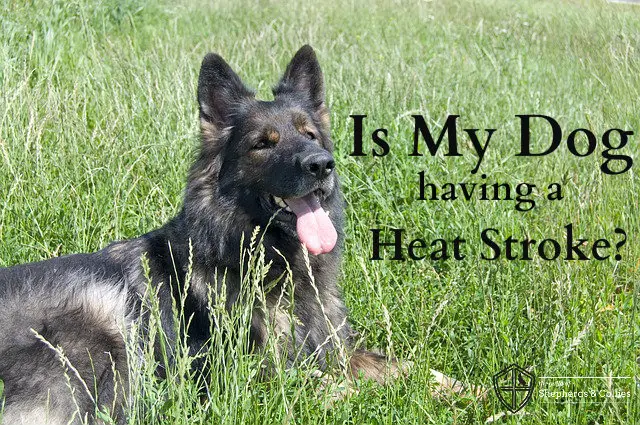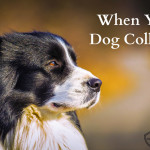Is My Dog Having A Heat Stroke — How to Spot the Symptoms
Heat Stroke Happens Quickly - Take Precautions and Follow These Tips
As daytime temperatures rise, outside activity becomes a priority—especially for your dog. Warm weather and longer days mean more exercise and playtime for your canine friend, but it can also spell danger in the form of heat stroke and heat exhaustion. Herding dogs, with their take-no-prisoners attitude, thick coat, and relentless energy are particularly at risk.
Need Activity and Exercise Ideas? Check out these great articles: Top 5 Indoor Activities for Your Athletic Dog, 6 Easy Ways to Meet Your Herding Dog's Exercise Needs, and Beat Bad Weather Blues with Indoor Games for Herding Dogs
Heat Stroke and Heat Exhaustion in Dogs
Dogs have only two methods for cooling themselves: panting and sweating from their foot pads. In addition to your dog’s limited ability to sweat, he also has no way of telling you how he is feeling. Herding breeds, whether working or not, are notoriously driven to get that last ball or round up the neighbor’s chickens. Don’t be fooled, however, he may seem ready to go another round, but he could be ignoring his own discomfort—you’ll have to serve as his watchdog. A high temperature is usually not present in heat exhaustion, so giving your dog a rest in a cool area and insisting he or she re-hydrate should suffice.
Left untreated, heat exhaustion can lead to heat stroke. If you are looking for a number, a temperature of 106°F or above is classified as heat stroke.
Heat exhaustion is tricky because many of the signs are not overt—in fact, they mimic that natural joie de vivre that your dog displays during normal exercising. Symptoms of heat exhaustion include panting, drooling, vomiting and diarrhea. Less obvious signs are an elevated heart and respiratory rate. Be watchful of your dog. You may write off a bit of drool or vomiting as exuberance or an episode of slipper chewing, when it could be a sign of overheating. In fact, vomiting often accompanies an excessively high body temperature. If your dog is displaying signs of heat exhaustion and it’s not remedied promptly, it will lead to heat stroke.
Heat stroke is a type of hyperthermia in which the body’s internal temperature becomes elevated due to external heat. Heat stroke is different from a fever in that it is brought on by warm environmental conditions, whereas a fever is part of the inflammation process that develops in response to ill-health, such as an infection. Though dogs, like humans, have varying resting temperatures, anything above 103°F is considered abnormal. Heat stroke can come on suddenly—a dog locked in a hot car or left in a non-shaded backyard can quickly overheat.
Heat stroke is considered a serious medical emergency. At 107°F, cellular damage begins. Waiting to treat the dog can result in kidney, liver and/or heart failure. Permanent damage that affects blood clotting, metabolism, muscle and brain function may result. Some dogs never thoroughly recover and may require special treatment.
Signs of Heat Trauma and Seeking Medical Attention
Periodically check your dog’s breathing, panting and gums. He may show labored breathing, increased panting and excessive drooling. On the other hand, he may suddenly stop panting and his mouth and nose may feel dry. Any change in behavior is worth a once over. Remember that your herding dogs may be exceptional in this area—his intensity of focus may veil physical distress.
Check your dog’s gums; healthy gums are moist and salmon pink. A dog experiencing heat stress may have dark red, blue or purple gums. Additionally, the pupils of his eyes may be dilated. More noticeable symptoms, such as uncoordinated movements, confusion, dizziness and seizures may vary from dog to dog. Seizures may not appear dramatic, so watch for tremors and shaking. Uncoordinated movements may simply show up as a slowed pace. This is where knowing your dog and trusting your intuition can really pay off. If your dog is exhibiting signs of heat stroke, it is imperative that you get him to a veterinarian.
Though you may be focused on transporting your dog to the vet, you will need to begin cooling him immediately. You may offer him a small drink of water, but don’t force him; if he will not drink, wipe his face with a moist cloth. Help your dog on the drive by providing a wet towel, particularly around the stomach, between the legs and across the neck. Make sure the towel does not retain heat. A fan or air conditioning is helpful. Never use ice as this can cause the blood vessels to constrict or precipitate shivering, both of which slow or stop the cooling process. Additionally, do not shock your dog by throwing water over him.
Guild Evangelist Deb M. Eldredge, DVM explains how to properly cool down your dog - the information provided will elaborate more on the dog's overall cooling process, helping you take care of your dog, should he display signs of heat trauma.
Important: Keep your dog calm; remaining calm yourself will help, since dogs tend to recognize stress in humans.
Protecting Your Dog from Heat Trauma
Protect your dog by always providing a shaded, well-ventilated area. In dry, hot locales, it is best to allow the dog access to the indoors where a fan or air-conditioning maintains a habitable temperature. Left alone, your herding dog may turn rambunctious —plan for his shenanigans so that he doesn’t overheat while you are away. Always provide fresh water and make sure the water dish is not easily knocked over. Dogs that have a thick coat should be groomed regularly to prevent a buildup of excess fur. Shaving the dog is generally not recommended because their coat, when properly maintained, serves as protection from the elements, heat included.
Keeping It Clean: Understanding Your Herding Breed's Cooling Process and Proper Coat Care
Important: Never leave your dog in the car— temperatures in the car can reach over 100°F within minutes, and an open window will NOT prevent heat trauma.
Prevention is not difficult, but you may have to shift your schedule to accommodate your fuzzy friend. High-energy herding breeds need a workout or they’ll make up their own— which may end up in more work for you. Don’t forgo his exercise regime. On those blistering days, exercise your dog in the early morning and evening when the heat is not so intense. If you must exercise during the day, or if your dog is a working dog, be sure to provide plenty of water and frequent breaks.
Remember that your dog sweats from his paws; hot asphalt can not only burn the dog’s feet, but affect his cooling mechanism. Similarly, muzzling a dog limits his ability to pant—his only other method of regulating his temperature.
When it comes to the weather, place yourself in your dog’s paws: high energy, lots of fur, a sweltering day—maybe an afternoon off in the comfortable confines of the home is the best policy.
Article By:
Andrea Peck







